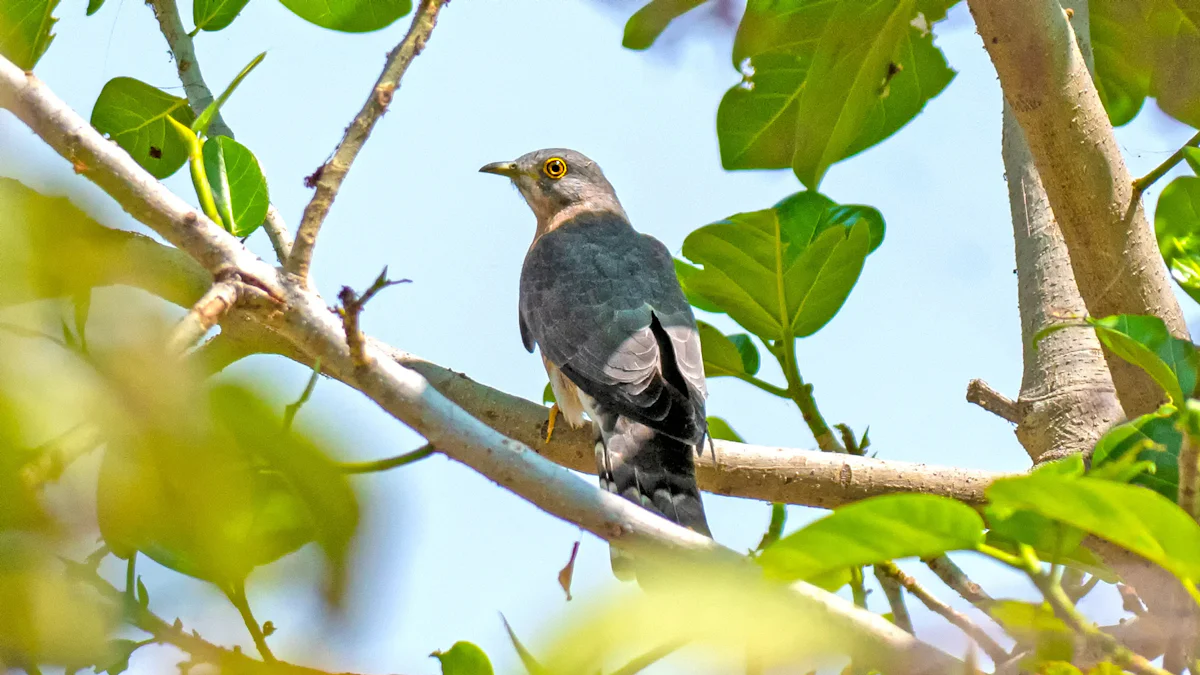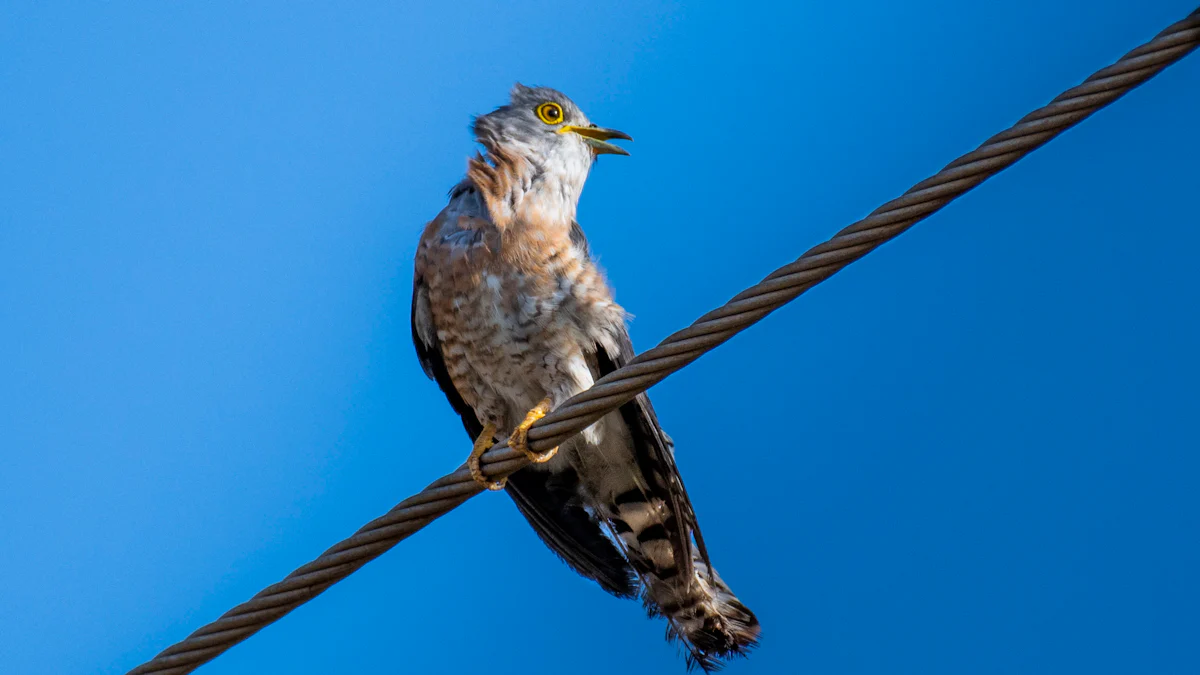
Have you ever paused to listen to the enchanting calls of a cuckoo bird? These sounds are not just melodies; they are vital communication tools in the avian world. Each cuckoo bird sound, with its unique rhythm and tone, plays a crucial role in nature. The number of syllables in their calls can even indicate the richness of bird species in an area. By understanding these calls, you gain insight into the environment and the fascinating lives of these birds. So, next time you're outdoors, take a moment to appreciate the symphony of cuckoo calls around you.
General Characteristics of Cuckoo Bird Sounds
Significance of Cuckoo Calls
Role in Communication
Cuckoo calls are more than just sounds; they are essential communication tools. When you hear a cuckoo, you're listening to a bird announcing its presence or marking its territory. Male cuckoos often sing from high perches, using their distinctive two-note "cuck-oo" call to attract females and ward off rivals. This call is not just a melody; it's a message that plays a crucial role in their social interactions.
Influence on Culture
Cuckoo calls have left a significant mark on cultures worldwide. For centuries, people have recognized the cuckoo's call, and it has inspired countless stories and beliefs. In Japanese folklore, the cuckoo symbolizes both death and rebirth, believed to travel between worlds and summon the dead. This bird's call evokes a sense of longing and melancholy, often reflected in literature and Haiku. In Sweden, the direction of a cuckoo's call is thought to predict future events, showcasing the bird's deep cultural significance.
Overview of Cuckoo Bird Species
Common Cuckoo
The Common Cuckoo is perhaps the most famous of all cuckoo species. Its iconic "cu-ckoo" call has inspired the design of cuckoo clocks. You can often hear this call during spring when males sing persistently to attract mates. The Common Cuckoo's call is not just a sound; it's a symbol of the changing seasons and a reminder of nature's rhythms.
Yellow-billed Cuckoo
The Yellow-billed Cuckoo has a unique sound that sets it apart. Its call consists of a series of hollow, wooden-sounding notes that can last up to eight seconds. Both male and female Yellow-billed Cuckoos produce a metallic, rattling call, along with a series of "kow-kow-kow" notes. These sounds resemble a metal door knocker, making them easily recognizable.
Black-billed Cuckoo
The Black-billed Cuckoo's call is distinct and intriguing. It features a guttural croak, often preceded by a rapid and harsh chortle. This call is less melodic than others but equally important for communication. When you hear the Black-billed Cuckoo, you're experiencing a unique aspect of nature's soundscape.
Common Cuckoo Bird Sound

Male Common Cuckoo Calls
Description of Calls
When you hear the male common cuckoo, you'll notice its iconic "cuck-oo" call. This sound is not just a simple melody; it varies in the number of syllables, depending on the environment and the presence of other cuckoos. Males often sing from high perches, repeating their calls persistently. This repetition helps them stand out in their habitat. Interestingly, these calls differ more among individual cuckoos than within the same bird, making each male's song unique.
Purpose of Calls
The male cuckoo's call serves several purposes. Primarily, it attracts females during the breeding season. By singing from exposed perches, males announce their presence and readiness to mate. Additionally, these calls help establish territory, warning other males to stay away. The variation in the number of "cuck-oo" syllables can also indicate the quality of the habitat, providing valuable information to potential mates and rivals.
Female Common Cuckoo Calls
Description of Calls
Female common cuckoos have a distinct call that sets them apart from their male counterparts. Instead of the "cuck-oo" sound, females produce a bubbling "kwik-kwik-kwik!" This call is both intriguing and essential for their interactions. Unlike the male's song, the female's call is less about territory and more about communication with other cuckoos.
Purpose of Calls
The female's bubbling call plays a crucial role during the breeding season. It serves as a signal to attract males and deter territorial rivals. This call can also deceive host birds, making them believe another bird species is nearby. This deception helps the female cuckoo lay her eggs in the nests of unsuspecting hosts, a behavior known as brood parasitism. By understanding these calls, you gain insight into the complex social dynamics of cuckoo birds.
Yellow-billed Cuckoo Bird Sound
The Yellow-billed Cuckoo offers a unique auditory experience in the world of bird sounds. Its calls are not just sounds; they are a fascinating part of nature's orchestra.
Male Yellow-billed Cuckoo Calls
Description of Calls
When you hear the male Yellow-billed Cuckoo, you'll notice a distinctive series of hollow, wooden-sounding notes. These calls can last up to eight seconds, creating a rhythmic pattern that stands out in the wild. The sound resembles a metal door knocker, making it easily recognizable. This call is not just a melody; it's a signature sound that helps identify the presence of this bird in its habitat.
Purpose of Calls
The male's call serves several important purposes. Primarily, it attracts females during the breeding season. By producing these unique sounds, males announce their presence and readiness to mate. Additionally, these calls help establish territory, warning other males to keep their distance. The variation in the number of syllables can also indicate the quality of the habitat, providing valuable information to potential mates and rivals.
Female Yellow-billed Cuckoo Calls
Description of Calls
Female Yellow-billed Cuckoos have their own distinct calls. They produce a metallic, rattling sound, along with a series of "kow-kow-kow" notes. This call is both intriguing and essential for their interactions. Unlike the male's song, the female's call is less about territory and more about communication with other cuckoos.
Purpose of Calls
The female's call plays a crucial role during the breeding season. It serves as a signal to attract males and deter territorial rivals. This call can also deceive host birds, making them believe another bird species is nearby. This deception helps the female cuckoo lay her eggs in the nests of unsuspecting hosts, a behavior known as brood parasitism. By understanding these calls, you gain insight into the complex social dynamics of cuckoo birds.
Black-billed Cuckoo Bird Sound
The Black-billed Cuckoo offers a unique auditory experience in the world of bird sounds. Its calls are not just sounds; they are a fascinating part of nature's orchestra.
Male Black-billed Cuckoo Calls
Description of Calls
When you hear the male Black-billed Cuckoo, you'll notice its distinctive guttural croak. This sound often starts with a rapid and harsh chortle, creating a unique rhythm that stands out in the wild. The call is less melodic than other cuckoo bird sounds, but it carries a certain charm that makes it memorable. Each male's call can vary slightly, influenced by environmental conditions and the presence of other cuckoos nearby.
Purpose of Calls
The male's call serves several important purposes. Primarily, it attracts females during the breeding season. By producing these unique sounds, males announce their presence and readiness to mate. Additionally, these calls help establish territory, warning other males to keep their distance. The variation in the number of syllables can also indicate the quality of the habitat, providing valuable information to potential mates and rivals.
Female Black-billed Cuckoo Calls
Description of Calls
Female Black-billed Cuckoos have their own distinct calls. They produce a metallic, rattling sound, along with a series of "kow-kow-kow" notes. This call is both intriguing and essential for their interactions. Unlike the male's song, the female's call is less about territory and more about communication with other cuckoos.
Purpose of Calls
The female's call plays a crucial role during the breeding season. It serves as a signal to attract males and deter territorial rivals. This call can also deceive host birds, making them believe another bird species is nearby. This deception helps the female cuckoo lay her eggs in the nests of unsuspecting hosts, a behavior known as brood parasitism. By understanding these calls, you gain insight into the complex social dynamics of cuckoo birds.
Identifying Cuckoo Calls in the Wild

Listening to cuckoo bird sounds in their natural habitat can be a thrilling experience. Whether you're a seasoned birdwatcher or a curious beginner, identifying these calls requires some know-how and the right tools. Let's dive into some tips and tools that can enhance your birdwatching adventures.
Tips for Birdwatchers
Best Times to Listen
Timing is everything when it comes to birdwatching. Early morning and late afternoon are the best times to listen for cuckoo calls. During these periods, birds are most active and vocal. The quiet of dawn and dusk allows you to hear the distinct sounds of cuckoos without the interference of other noises. So, grab your binoculars and head out during these golden hours for the best chance to catch a cuckoo's call.
Recognizing Patterns
Recognizing patterns in cuckoo calls can help you identify different species. Pay attention to the rhythm and repetition of the calls. For instance, the male common cuckoo's two-note "cuck-oo" is quite distinct. In contrast, the Yellow-billed Cuckoo's call features a series of hollow, wooden-sounding notes. By familiarizing yourself with these patterns, you'll become adept at distinguishing between various cuckoo bird sounds.
Tools for Identification
Audio Recorders
Using an audio recorder can greatly enhance your ability to capture and analyze bird sounds. Devices like the Marantz PMD-620 MKII recorder offer high-quality sound recording, making it easier to study the nuances of cuckoo calls. With a sampling rate of 48 kHz and 24-bit quality, this recorder ensures you don't miss any details. Recording the calls allows you to replay and compare them later, aiding in accurate identification.
Birdwatching Apps
In today's digital age, birdwatching apps have become invaluable tools for enthusiasts. Apps like Xeno-canto provide access to a vast database of bird calls, including those of cuckoos. You can listen to recordings from different regions and compare them with what you hear in the wild. These apps often come with features like sound recognition, which can help you identify cuckoo bird sounds on the spot. By using technology, you can enhance your birdwatching experience and deepen your understanding of these fascinating creatures.
Cuckoo bird sounds are more than just enchanting melodies; they are vital to understanding the natural world. These calls, often heard in serene places like the Murlough National Nature Reserve, signal the arrival of spring and the promise of warmer days. Listening to a cuckoo bird sound can be a moving experience, encouraging you to connect with nature and embrace your creative side. So, venture outdoors, tune into these captivating calls, and let them inspire you. Whether you're a seasoned birdwatcher or a curious explorer, the world of cuckoo calls awaits your discovery.
If you’re passionate about birds and want to learn more, we invite you to explore our blog list! Dive into a variety of topics that cover everything from birdwatching tips and species profiles to conservation efforts and fascinating bird behaviors.












